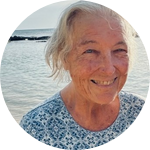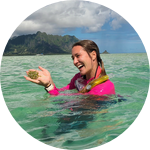About This Project
Seagrass meadows are vital for the health of the ocean because of their ability to absorb carbon from the water and create oxygen. Additionally, seagrasses serve as food and shelter for beloved animals like the endangered green sea turtle. Even though seagrasses are very important seagrass coverage is being lost globally at a rate of 1.5 percent per year. In order to preserve this ecosystem we must learn more about it through genetic analysis.
Ask the Scientists
Join The DiscussionWhat is the context of this research?
Seagrasses are important ecosystem services, they provide food for various organisms, control erosion and sequester carbon. With the high proportion of coastlines to geographic area in the island state of Hawaii, these ecosystems are vital to protecting the coastline, yet this ecosystem service remains largely unappreciated. Seagrass populations are declining globally, but to work towards restoration there is a need for ongoing assessments of the status of local seagrass populations. By understanding the patterns of genetic diversity and connectivity within and among populations of the two species of seagrass found in Hawaii it will make it easier to plan seagrass management and restoration strategies.
What is the significance of this project?
Seagrass is an important defense against climate change. Each square meter of seagrass produces 10 liters of oxygen each day and seagrass beds are capable of storing more than 80 million metric tons of carbon a year. Here in Hawaii, we have a rare endemic seagrass (Halophila hawaiiana) that little is known about and our beloved green sea turtle relies on this ecosystem as food. My project will shed more light on the population structure of seagrasses here in Hawaii, which is important for management practices. If we find that seagrasses here in Hawaii are not genetically diverse than one single disease could wipe out the entire population and devastate many species that rely on seagrass for their habitat and food.
What are the goals of the project?
The goal of this project are to determine how genetically diverse the endemic seagrass (Halophila hawaiiana) is compared to the cosmopolitan species (Halophila decipiens). In order to do this I need to collect seagrass at different locations throughout Oahu and extract the DNA from each plant. Next, I will use primers that I will order to amplify specific parts of the DNA of each plant. Following that I will send my samples to the University of Hawaii which will get me sequences for each plant and then I can compare the two species using a computer program. The data collection for this research will be completed during the summer of 2022 and the data analysis is expected to be completed in early Fall of 2022.
Budget
Once seagrass has been collected the DNA extraction kits will be used to extract DNA from the leaves. Then the extracted DNA will need to be run with pair of Primers in order to amplify a specific region of DNA. Finally, the samples will be sent away to University of Hawaii to be sequenced.
Endorsed by
 Project Timeline
Project Timeline
It is expected that this research project will be completed by December of 2022. My initial timeline looks to be completed with field work by early May and then begin laboratory work. Laboratory work should be completed by the end of June and at that time data analysis will begin once the sequences are received from the University of Hawaii.
May 06, 2022
Collect seagrass around Oahu
Jun 03, 2022
Complete DNA Extraction
Jun 11, 2022
Perform PCR
Jun 18, 2022
Send samples to University of Hawaii to be sequenced
Aug 01, 2022
Project Launched
Meet the Team
Kyla Richards
Aloha! My name is Kyla and I am from Seattle, Washington. I first became interested in seagrass when I studied how wasting disease was affecting Zostera marina, a seagrass found in my home waters of the Puget Sound. After obtaining my undergraduate degree I went on to get my Masters of Marine Science at Hawaii Pacific University under the advisory of Dr. Catherine Unabia. In my free time I enjoy diving, playing golf and hiking.
Lab Notes
Nothing posted yet.
Project Backers
- 5Backers
- 112%Funded
- $1,010Total Donations
- $202.00Average Donation


